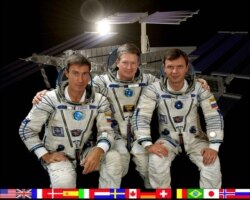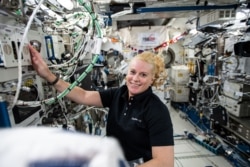The International Space Station was just three small rooms when the first crew moved in. The crew members soon discovered there was hardly any space for them to move around. The air was warm and humid, making them feel sticky.
Twenty years and 241 visitors later, the space station has a lookout tower, enough space for six people to sleep and 12 rooms, depending on how you count.
Monday marked 20 years since people first began living on the space station. Astronauts from 19 countries have spent time there. That includes repeat visitors who arrived on spacecraft for short-term repair or building projects, and several tourists who paid their own way.
The first crew
The first crew — American Bill Shepherd and Russians Sergei Krikalev and Yuri Gidzenko — left Earth on October 31, 2000. Two days later, they opened the doors to the space station, holding hands in a sign of unity.
Bill Shepherd was the space station’s first commander. He likened his time living there to living on a ship at sea.
The three-man crew spent most of their time trying to get the equipment to work; heat from some of the devices made the living space too warm. Adding machinery and making repairs took hours, compared to minutes on the ground, Krikalev remembered.
“Each day seemed to have its own set of challenges,” Shepherd said during a recent panel discussion with his former crewmates. Their reunion was organized by NASA, the U.S. space agency.
Today the space station is almost as large as a football field and has three modern laboratories. The station has enough solar power equipment to fill almost four-tenths of a hectare, and enough electrical wiring to stretch 13 kilometers.
Shepherd is long retired from NASA and lives in Virginia Beach, Virginia. Krikalev and Gidzenko continue to work for the Russian space agency. The two were involved in the launch of the space station’s 64th crew last month.
The first thing the first crew did upon arriving at the darkened space station on November 2, 2000, was turn on the lights, which Krikalev recalled as "very memorable.” Then they heated water for hot drinks and activated the lone toilet.
“Now we can live,” Gidzenko remembers Shepherd saying. “We have lights, we have hot water, and we have (a) toilet.”
Twenty years later
The space station did not come close to hitting any space objects during their nearly five months up there, Shepherd said, and the station has held up relatively well.
Today NASA’s top concern is the growing threat from space junk. This year, the space station has had to move around objects three times.
As for life on the space station, astronauts now have near-continuous communication with flight controllers and even an internet phone for personal use. The first crew had periodic radio contact with the ground; communication problems could last hours.
Astronauts spend most of their six-month stints these days keeping the space station running and performing science experiments. A few have even spent close to a year up there on a single flight.
It takes only 90 minutes for the station to circle the world, giving crew members a chance to enjoy 16 sunrises and 16 sunsets each day.
While more men have served on the space station than women, more crews today are likely to include women. Two U.S. women have served as the space station’s commander. Commanders usually are American or Russian, but have also come from Belgium, Germany, Italy, Canada and Japan.
Monday was a major anniversary for the International Space Station. But the space station has, in fact, spent 22 years in Earth’s orbit, and its first piece was launched into space in 1998.
NASA and its partners say the space station easily has several years of usefulness left. Russia’s Mir station operated for 15 years in the late 1980s and 1990s. America's 1970s Skylab spent much less time in space, as did China's much more recent orbital missions.
Shephard said that the past 20 years of international experience and cooperation can help massive projects, like possibly sending humans to the planet Mars.
“If you look at the space station program today, it’s a blueprint on how to do it,” Shepherd said. “All those questions about how this should be organized and what it’s going to look like, the big questions are already behind us.”
I’m Jonathan Evans.
The Associated Press reported this story. George Grow adapted the report for VOA Learning English. Hai Do was the editor.
_______________________________________________________________
Words in This Story
humid – adj. containing enough water or water particles to make one feel sticky
tower – n. a tall, narrow structure
tourist – n. a traveler
solar – adj. involving or related to the sun
challenge – n. an invitation to take part in a competition; a test
toilet – n. a large container connected to a system for removing waste products or liquids
mission – n. an important project or trip
blueprint – n. a design plan
We want to hear from you. Write to us in the Comments Section, and visit our Facebook page.










